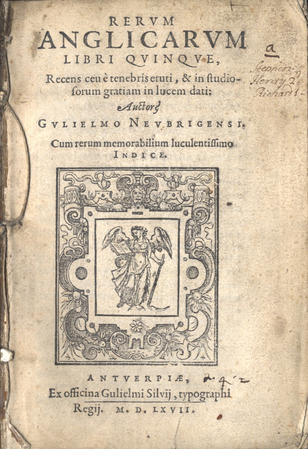1196 (ca.): The Undead Nuisance of Buckingham
One of the earliest collections of English history was written in the 10th Century by William of Newburgh [ca. 1136-1198], and it covers the known history of England from around 1066 to William's death in 1198. The history was compiled from older history texts that William felt were reliable, and from verbal accounts of knowledgeable people in relation to more recent historic topics.

Title page of Historia Rerum Anglicarum [Larger version here]
Overall, William tried to give as accurate an accounting of the events he covered as he could... which is why the few places he choose to go off the topic of history in his texts are so intriguing. For example, in William's fifth volume of his Historia Rerum Anglicarum, he took time out to note the somewhat unusual matter of dead people rising from their graves at the time of his writing the text!
He didn't know how or why these matters were happening, but he had heard enough reports from channels and people he trusted that, for him, established it was in fact happening. William was intrigued not only by the reports, but also from the lack of such reports in the historic documents he had been consulting... so he concluded this was a new problem, not a repeating one. William gives details of four separate events, one of the which follows.
The Undead Nuisance of Buckingham
A local man in the county of Buckinham died, and his wife and kin made the arrangements so that he was laid to rest in a tomb on the "eve of the Lord's Ascension," which means on the Wednesday before the traditional Thursday celebration of the Biblical miracle of the prophet Jesus rising from the dead. Now I can't say if the nature of the holiday had any effect on the matter, but that very same Thursday night the dead man came home and laid himself upon his wife's bed, both horrifying her and nearly crushing her with the weight of his body. The dead man returned the following night as well and assaulted his living wife in the same manner; so as the third night approached, the sensible woman both stayed awake to watch for him, and surrounded herself with companions. Sure enough the dead man returned again, but the group was able to drive him away.
The dead man next started to harass his living brothers, who lived in the same street, in the same way. They also recruited a number of companions, and waited to drive off the dead man... who then assaulted the animals of the house by way of punishment. Soon everyone on that street was wary of the dead man's visits, and all houses kept an eye out for the dead mischief maker after dark; and then the dead man began to appear during the daytime to assault people. These daytime assaults were particularly strange, for when encountering groups of people only some of the people in the groups could actually see the dead man... but his actions were still obvious to all.
This was, apparently, enough. The residents sought the council of the church, where the whole strange affair was detailed out for the Archdeacon Stephen -- who personally told the story to William of Newburgh later, by the way -- and Stephen wrote of the matter to the bishop of London to get guidance on handling it. The bishop, upon making inquiries, was informed that this sort of problem "had often befallen in England," and that the general solution was to dig up the offending corpse and burn it. This idea struck the bishop as just plain "improper and indecent," so the bishop instead wrote a letter of absolution, forgiving the dead man of any unstated sins, and sent this with instruction to the archdeacon to open the tomb, check the state of the body, and reseal the tomb with the letter placed upon the breast of the corpse. And, having done this, the dead man no longer bothered the community.
It's interesting to note that while the night-time visits of the dead man conform to normal expectations of a physical undead return, the later day-time instances appear to imply the presence of the dead man's ghost instead, with further implication of poltergeist activity if the dead man could effect people who couldn't see him. It's a strange tale all around, and one that William got firsthand from the archdeacon Stephen.
The Dating of the Event
Though a direct date is not given by William of Newburgh for any of these strange events, he does say they were 'recent' to the time of his writing... and many historians believe this section of the histories was written around 1196, as this is when other events William discusses in this part of his history took place. In addition, I can say the problems started on a Thursday sometime in April, May, or June, because Ascension Day is always on a Thursday in that time frame; and Ascension Day is when the trouble started. The specific date for Ascension Day does change from year to year, however; so without knowing the exact year of this event, I can't give the exact date.
Anomalies -- the Strange & Unexplained, as well as my other website -- Monsters Here & There -- are supported by patrons, people like you! All new Anomalies articles are now posted for my patrons only, along with exclusive content made just for them. You can become a patron for just $1 a month!
|








